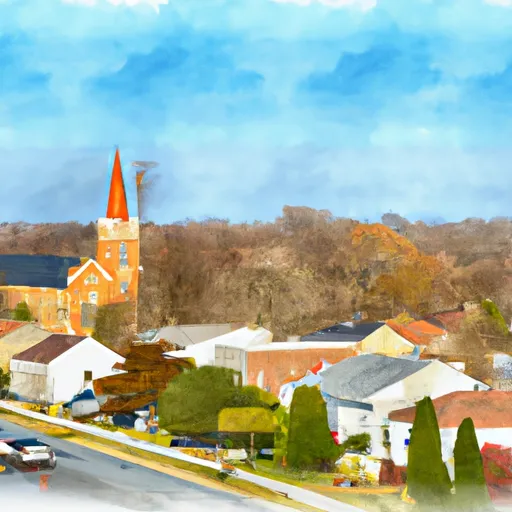-
 Snoflo Premium
Snoflo Premium
Get unlimited access to all our content
With no Ad interruptions! - Start Your Free Trial Login with existing account
Montchanin
Eden Index
Climate
9.5
•
Recreation
4.2
•
Community
3.2
•
Safeguard
6.1/10

Montchanin, Delaware, located in New Castle County, offers a charming small-town atmosphere with a rich history. The climate in Montchanin is considered moderate, with warm summers and cool winters. Summers typically see temperatures ranging from the mid-70s to mid-80s°F, while winters range from the mid-30s to mid-40s°F. Precipitation is evenly distributed throughout the year, with an average annual rainfall of around 45 inches.
Montchanin sits in the Brandywine Creek Watershed, which contributes to the hydrology of the area. The Brandywine Creek, a major waterway, flows through Montchanin, providing opportunities for various outdoor activities like kayaking, canoeing, and fishing. The creek is known for its diverse aquatic life and tranquil surroundings.
Montchanin and its surrounding areas offer several outdoor recreation opportunities. The nearby Brandywine Creek State Park provides numerous hiking and biking trails, picnic areas, and nature programs. The park is also home to a nature center that hosts educational activities for visitors. Additionally, the Hagley Museum and Nemours Estate, both located nearby, offer visitors a chance to explore historical gardens and picturesque landscapes. Overall, Montchanin's climate, hydrology, and outdoor recreation opportunities make it a delightful destination for nature enthusiasts and history buffs alike.
What is the Eden Index?
The Snoflo Eden Index serves as a comprehensive rating system for regions, evaluating their desirability through a holistic assessment of climate health, outdoor recreation opportunities, and natural disaster risk, acknowledging the profound impact of these factors on livability and well-being.
Climate Health Indicator (CHI): 9.5
Montchanin receives approximately
1234mm of rain per year,
with humidity levels near 78%
and air temperatures averaging around
13°C.
Montchanin has a plant hardyness factor of
7, meaning
plants and agriculture in this region tend to thrive during the non-winter months.
By considering the ideal temperature range, reliable water supplies, clean air, and stable seasonal rain or snowpacks, the Climate Health Indicator (CHI) underscores the significance of a healthy climate as the foundation for quality living.
A healthy climate is paramount for ensuring a high quality of life and livability in a region, fostering both physical well-being and environmental harmony. This can be characterized by ideal temperatures, reliable access to water supplies, clean air, and consistent seasonal rain or snowpacks.
Weather Forecast
Streamflow Conditions
Lower Delaware
Area Rivers
Lower Delaware
Snowpack Depths
Lower Delaware
Reservoir Storage Capacity
Lower Delaware
Groundwater Levels
Recreational Opportunity Index (ROI): 4.2
The Recreational Opportunity Index (ROI) recognizes the value of outdoor recreational options, such as parks, hiking trails, camping sites, and fishing spots, while acknowledging that climate plays a pivotal role in ensuring the comfort and consistency of these experiences.
Access to outdoor recreational opportunities, encompassing activities such as parks, hiking, camping, and fishing, is crucial for overall well-being, and the climate plays a pivotal role in enabling and enhancing these experiences, ensuring that individuals can engage in nature-based activities comfortably and consistently.
Camping Areas
| Campground | Campsites | Reservations | Toilets | Showers | Elevation |
|---|---|---|---|---|---|
| Dover AFB Military | None | 25 ft |
Nearby Ski Areas
Catastrophe Safeguard Index (CSI):
The Catastrophe Safeguard Index (CSI) recognizes that natural disaster risk, encompassing floods, fires, hurricanes, and tornadoes, can drastically affect safety and the overall appeal of an area.
The level of natural disaster risk in a region significantly affects safety and the overall livability, with climate change amplifying these risks by potentially increasing the frequency and intensity of events like floods, fires, hurricanes, and tornadoes, thereby posing substantial challenges to community resilience and well-being.
Community Resilience Indicator (CRI): 3.2
The Community Resilience Indicator (CRI) recognizes that education, healthcare, and socioeconomics are crucial to the well-being of a region. The CRI acknowledges the profound impact of these elements on residents' overall quality of life. By evaluating educational resources, healthcare accessibility, and economic inclusivity, the index captures the essential aspects that contribute to a thriving community, fostering resident satisfaction, equity, and social cohesion.

